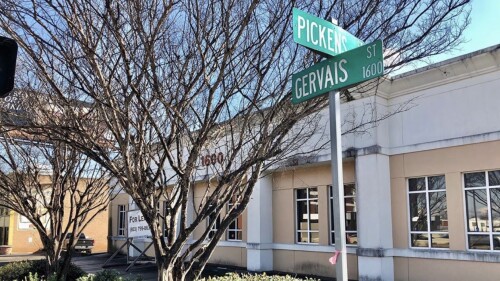...Read this. 🏡
Reasons why living in Cola is the coolest: 1. Small-town vibe with big(ger) city elements 2. Affordable cocktails 3. Commitment to preserving all things historic.
Together, our 15 downtown historic districts filled with beautiful old homes weave a story that is uniquely Columbia, revealing a piece of our history from block to block. As my contractor put it when my boyfriend + I were in the process of purchasing our 1930’s-era Shandon home, homes “just aren’t built like that anymore.”
Studies have shown that houses within local historic districts are often worth more, appreciate faster and retain more of their value than properties located outside of districts. So, naturally, there are gonna be some rules that come along with owning one. (Remember this story in The State?)
We chatted with Rachel Walling, Senior Preservation Planner for City of Columbia, to find out some of those regulations – and why they’re in place. ⬇
Regulations are put on properties within Cola’s 15 historic districts that limit the buyer’s ability to make drastic changes to the exterior of the building. Each district has its own set of guidelines. This is so neighborhoods are protected against intrusive design or widespread demolition. Design changes must be approved by the City’s Design/Development Review Commission (DDRC) before they can be made; and the Preservation Staff within the City’s Planning and Development Services oversee the districts.
✔ What’s regulated?
Depending on the level of designation, design preservation reviews:
🔨 Exterior changes (like several districts’ rule against replacing historic windows)
🔨 Additions/enclosures (like my friend’s home, when they had to replicate how many windows would have been in a room, historically, when they added an addition)
🔨 Fences
🔨 Walls
🔨 Signage
🔨 Driveways/parking lots
🔨 Demolition/relocation
🔨 New construction
Review is triggered when the owner applies for a building or zoning permit for exterior work. But homeowners should consult the Preservation Staff to get approval *before* starting any exterior work.
✖ Work not visible from the public right-of-way + interior work is not reviewed.
Earlewood Protection Area home renovation
Two types of Design Preservation:
1️⃣ Architectural Conservation District = area of the city that contains a number of buildings constructed in a similar architectural style or constructed during the same time period. These preserve the form of the neighborhood *and* the general character of its individual structures, including the preservation of historic materials. Generally, all exterior work – including changes to windows, siding, porch details + more – is reviewed and is typically required to match the original work.
2️⃣ Protection Area = area that contains some historic buildings or landmarks, but also has many non-historic or marginal buildings. These protect the general form + character of the district as a whole vs. individual structures. Review of work is limited to additions, new construction, demolition + certain site improvements (like fences + driveways). Modern materials that replicate historic appearance may be considered in both ACD + PA areas.
How does a DDRC meeting work?
DDRC holds monthly public hearings. I went to January’s to see what goes down.
The DDRC staff (a.k.a. the preservation planners) hear from City Staff, the applicant (i.e. you, with your application all filled out) + members of the public wishing to speak about the proposal. Using the design guidelines, the Commission then makes a ruling to approve, approve with conditions, or deny the request. Denials may be appealed to a court of competent jurisdiction within 30 days.
If you’re a historic preservation nerd like me, check out the 2018 schedule of meetings or watch live on the City’s website.
Does Design Preservation affect taxpayers?
Historic designation alone does not increase taxes (which are based on the assessed property value of the land + improvements) but: it may add to the desirability of a neighborhood → possibly more real estate market activity → possibly higher assessed property values → possibly higher taxes.
What about tax breaks?
The City offers a tax incentive program for homeowners making changes to historic homes called the Bailey Bill: if the homeowner invests 20% of the home’s value back into the home with preservation-related expenses, then the property taxes will stay at the pre-rehab assessed value for 20 years.
Columbia isn’t the only S.C. city that has to check with local government before making exterior home reno’s in historic neighborhoods. Both Charleston + Greenville have city-regulated design + development review boards for their historic districts, too.
I like to think that our 15 historic neighborhoods give Cola that hygge vibe. Driving throughout our city, passing by Old Shandon bungalows + deep Elmwood Park porches in the shade of mature trees, you get the feeling that Columbia is home – even if you didn’t grow up here. It’s a sense of comfort that larger, commercialized urban metropolises can’t provide.












